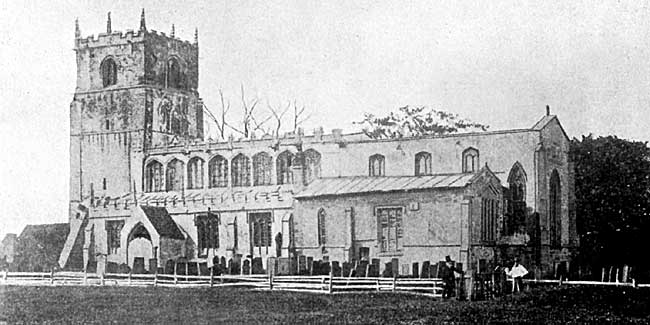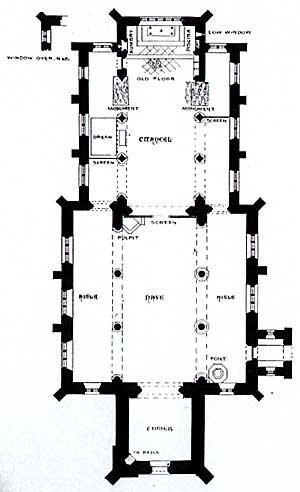Laxton

St Michael's Laxton. Previous to restoration.
After passing through Moorhouse, Laxton Fields, where the open-field system of agriculture still survives in a modified form, were traversed in a drenching shower.
This property belongs to Earl Manvers, and at a later period in the day, Mr. W. Stevenson took an opportunity of explaining the leading features of this old communal system of agriculture, which still holds its own in this partially unenclosed lordship. It was explained that the wheat field of this year would be a pulse crop next year, and then lie a year in fallow, in the latter case with the broad headlands of grass to become the communal sheep pasture of the lordship by which the land would be again prepared for corn.
There are no hedges, but the “lands” are divided by baulks of unploughed turf. The Enclosure Acts dealt a blow to this open-field system in many places, a system of straggling, scattered holdings being very wanting in economy, and prolific in quarrels among the tenants as to rights of way over the headlands, and between the clean holder and the slovenly holder.
Mr. R. W. Wordsworth, agent to Earl Manvers, has kindly furnished some particulars of the system:—
Laxton open-fields contain roughly 900 acres in all, divided into approximately 1,200 plots. They are cropped in rotation, thus: One field, white straw; one field, pulse or clover; one field, bare fallow. Each of the tenants, of whom there are thirty, has a certain acreage in each field, and most of them small pieces dotted about, so as to give them a bit of each class of soil which the field contains, and there are many. To have one acre in any one part is considered quite a large piece; many do not occupy half that quantity.
There are juries chosen annually to go over each field to see that the commons interspersed in them are not encroached upon, and that no one ploughs nearer the road than he should.
There are many old words in use in the parish in connection with these fields, which no doubt are becoming obsolete, such as “sick” (or syke), “stenting,” &c. The former is a grass baulk, the latter the place where two “lands” abut on each other, and the person who ploughs last turns his plough and horses on the other man’s land, which is already ploughed, much to his detriment. How they all know their proper pieces is a marvel. There is an old saying in Laxton, that if you are first in the field with your harvest cart and last with your muck cart or plough, you are sure to be right. They are a peculiar people. The village is divided by the church into what are known as “up the street” and “down the street,” and these two parts are distinctly antagonistic to each other. The only time they combine is when a stranger ventures to take land in the parish, then they all pick him like a flock of crows.
Laxton Church now came into view, forming a handsome and conspicuous feature in the landscape. On alighting at the church gates the vicar, the Rev. Christopher B. Collinson, met the party, most of whom at once proceeded up the grassy lane that connects the church with the great Manor site, mound or burh of the lordship, called the “Old Hall Grounds,” the largest earthwork in the county. Here Mr. T. M. Blagg gave a short address on the subject, pointing out the rectangular lines of the first enclosure, in which the soil is intensely black, denoting a long occupation, and the remains of masonry in its banks. From this commanding height the lines of the second or outer court could be traced in the adjoining field, together with a secondary mound not generally noticed by casual visitors. It is possible that the earliest enclosure was Roman; the great burh is Anglo-Saxon, and .the whole was occupied to the close of the middle ages by the chief lords of Laxton, who were the hereditary custodians of the royal forests of Notts. and Derbyshire to the end of the reign of Edward I.
After luncheon at the village hostelry, known as “The Dovecote,” the church was visited, where the vicar, read the following paper:—
There are three subjects of antiquarian interest in Laxton. The Church of St. Michael, the large earthworks, called locally “The Old Hall Grounds,” and the unenclosed lordship, still cultivated on the “three field” system; the history of these, for many centuries, has been bound up with the great lords of the soil, and offers a fruitful field for the study of mediaeval life.

Ground plan of Laxton church.
No mention is made of a church at Laxton at the Domesday Survey, but this is not evidence of the nonexistence of such a building.
In the south side of the tower is built a stone with Norman architectural ornament upon it.
There was a church here in King Stephen’s time, which was given to the prior and convent of Shelford by Ralph Alselin, the Norman lord of Laxton, and founder of Shelford Priory.
The earliest rectors we can trace are R. de Lexington and John de Sutton,1 presented by the Prior and Convent, the latter in 1240. An exchange with Gotham seems to have been made in the 13th century, when the advowson came back to the lords of the manor. Adam de Everingham, the then lord, presented on May 28, 1329.
The present tower is a re-building of an older one, and we have, the original arch, the sculptured ornaments on which, coupled with the architectural details of the nave arcades, bespeak them as Transitional, Norman to Early English, dating circa 1190. The west doorway is fully a century later, and was possibly an insertion in the old tower. To this later date may be assigned the addition of an upper stage, demolished in 1860. The clerestory of the nave, a fine piece of work, is a contribution by Archbishop Rotherham (1480-1500), who acquired the advowson, a valuable one, and gave it to his College of Rotherham. This benefactor is figured in a mitre on the north battlements, with his right hand raised in blessing, and his left holding his cross. Beneath his feet are sculptured three stags, in positions not very heraldric, but clearly referring to his arms, viz., “Vert, three bucks trippant argent, attired or.”
The stone corbels supporting the roof are alternately sculptured as Apostles, with their symbols, and angels bearing musical instruments, above which, carved in wood, are demi-angels bearing shields, at one time richly coloured. The church, unfortunately, lost a number of the above figures during the restoration of 1860. The western arches of each of the arcades were then destroyed, and the tower was re-built one bay further east. The whole of the south, west, north, and part of the east walls of the church are modern; also all the slated roofs. The walls on the south and north are not built on the old foundations, but within the area of the older church, with the object of contracting it in width to conform with the smaller number of inhabitants, and the diminished importance of the village. This part of the church contains heraldric bearings, both internally and externally, the de Roos coat being prominent on the rafters, and that of Longvillers on the south battlements. There is one coat unidentified, and another on which the bearings are so badly cut that I doubt if they were ever recognisable. Without doubt the clerestory windows contained much painted glass, which has utterly perished. The cross at the east end of the gable of the nave is in the form of the letter M, and was formerly at the east end of the chancel. In the north aisle are portions of a dated oak screen,, somewhat richly carved, erected by Robert de Trafford in 1532, inscribed with his name, the salutation of the Virgin, and a shield with a representation of the five wounds of Christ.’ The chancel screen is original and is possibly Bishop Rotherham’s work.
(1) Robert Sutton, of Aram, co. of Nottingham, was, in consideration of the eminent services he had rendered to the royal cause during the Civil War, elevated to the peerage, by letters patent, dated 21 November, 1645, as Baron Lexinton, a name taken from Lexington, now called Laxton, co. Nottingham, which Lordship Richard Lexinton held In the reign of King John . . . —Burkes’ Dormant and Extinct Peerages.
